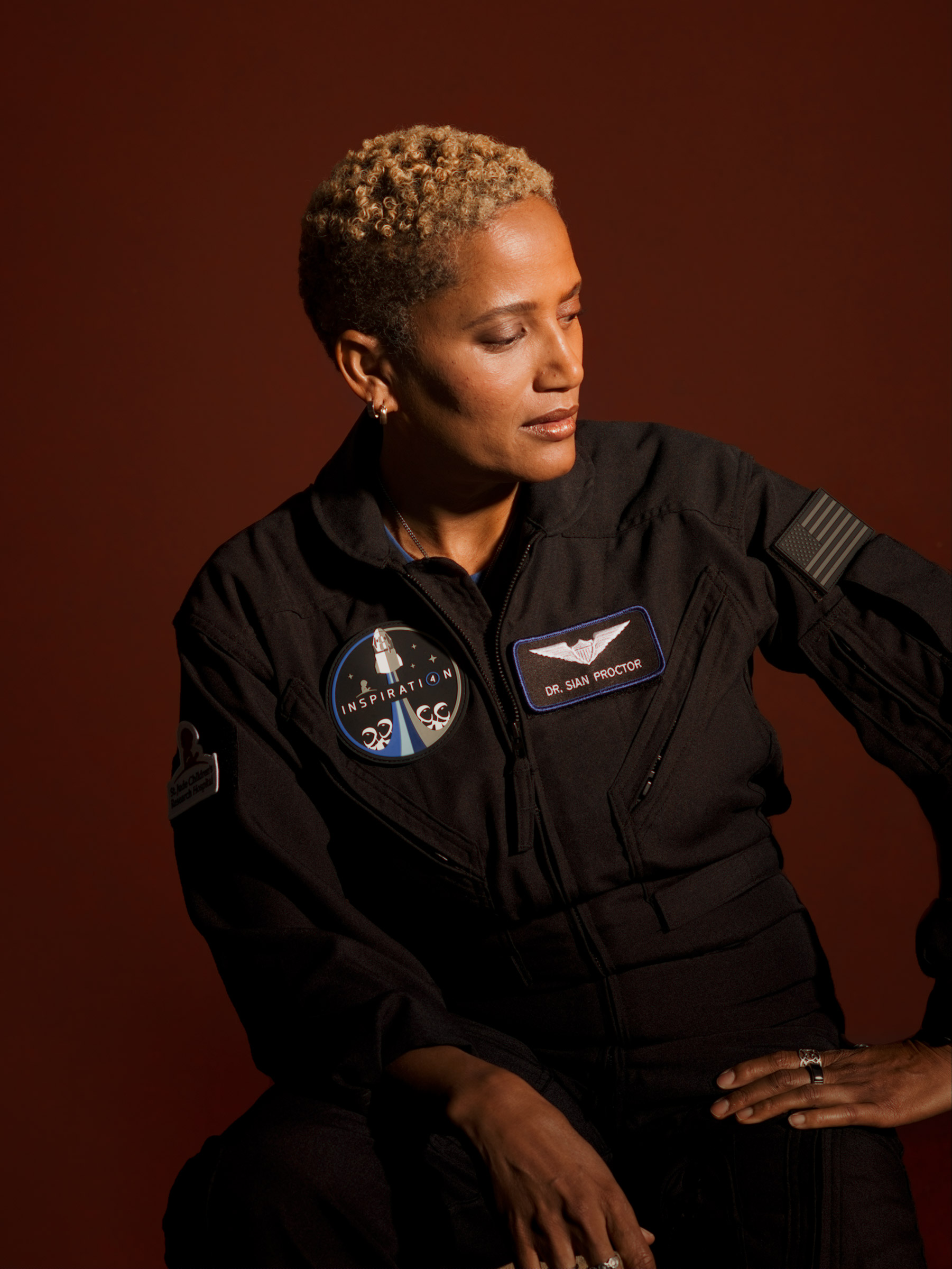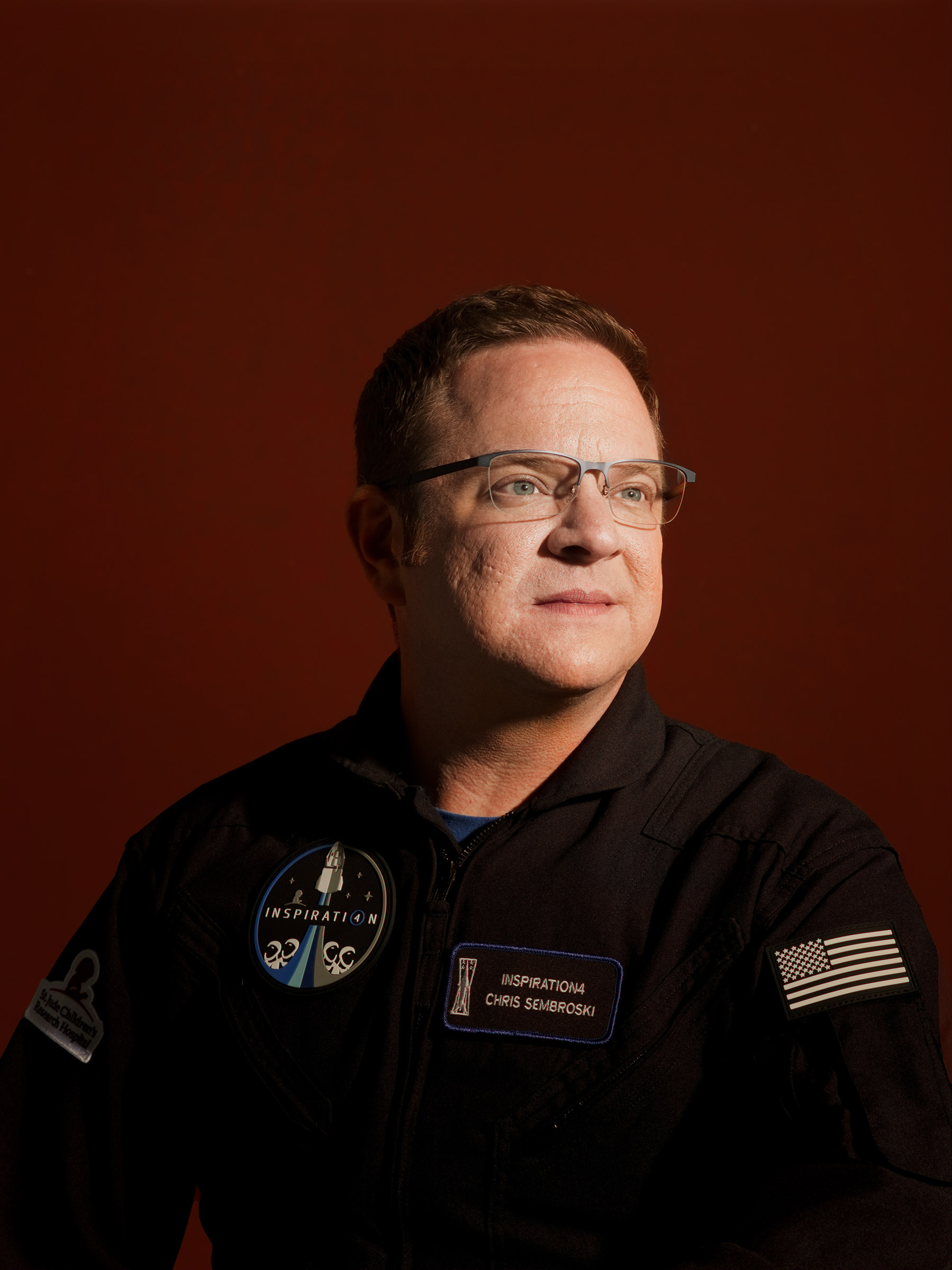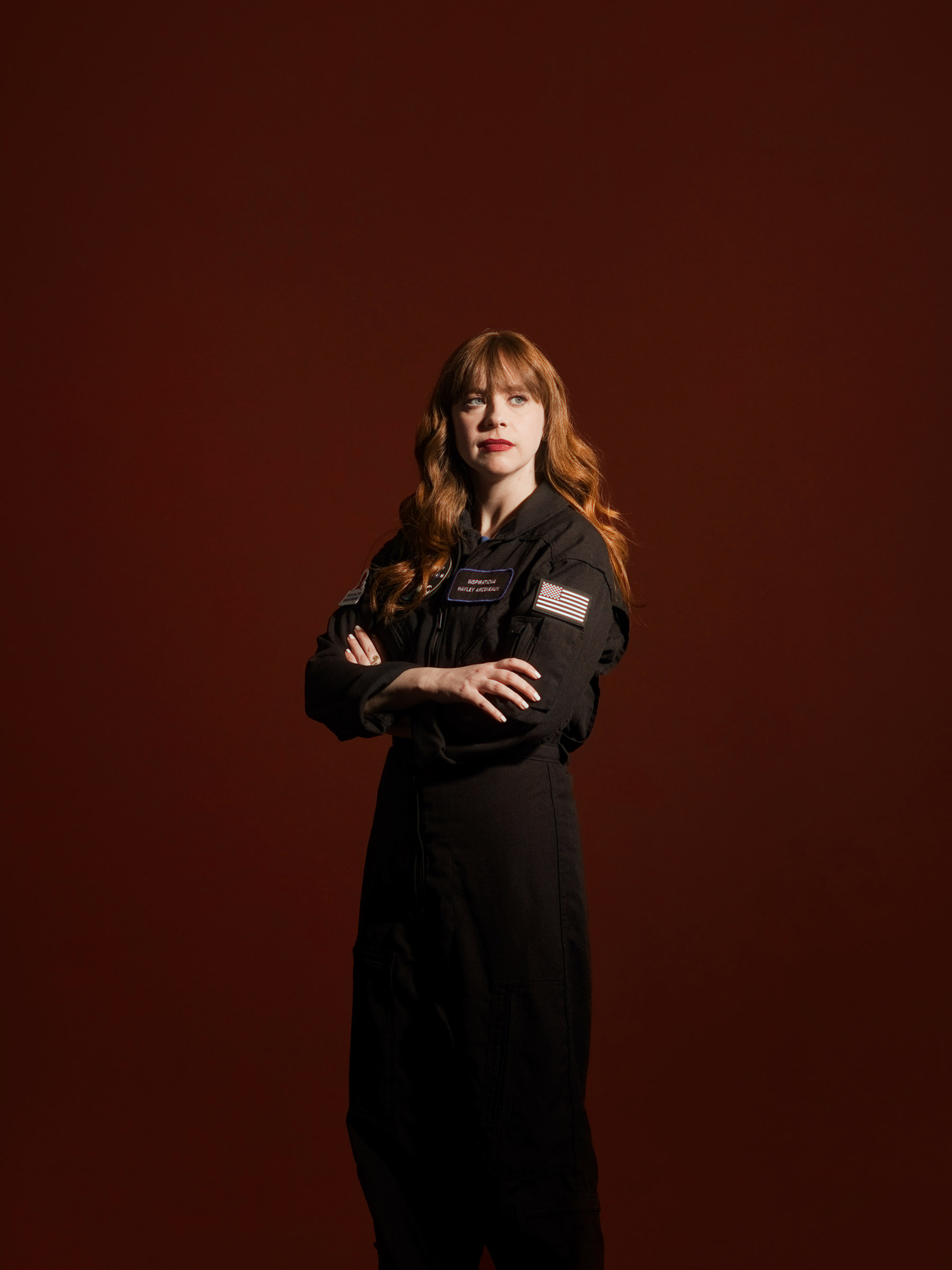
TIME Studios is producing the Netflix documentary series Countdown: Inspiration 4 Mission to Space, starting Sept. 6.
Astronauts are accustomed to celebrity status, and Jared Isaacman, 38, is learning that truth first-hand. Isaacman is the billionaire CEO of Shift4 Payments, an online payment company, who bought all four seats aboard a SpaceX Crew Dragon spacecraft and, come September, will command Inspiration4, the first orbital space mission crewed entirely by non-professional astronauts.
But if Isaacman’s name is becoming increasingly well-known in space circles, those of the other crew members are less so. Here’s a look at who they are, how they were selected to make their improbable journey, and what they hope to accomplish while aloft.
Sian Proctor

Two of the most memorable moments in Sian Proctor’s life involved a phone call—though the first she’d just as soon forget. That one came in 2009, when she was in contention for selection as a NASA astronaut. It was her first of two attempts, and while she wouldn’t get very deep into the selection process the second time around, the first time she was one of 47 candidates remaining out of 3,500 who had applied. Then came the call from NASA’s astronaut office.
“It was the yes-or-no call,” Proctor says. “And for me it was a no.”
Twelve years later, things were decidedly different. Proctor, 51, learned about Inspiration4 when friends emailed her about the TV ad that ran during the 2021 Super Bowl announcing both the mission and that Issacman was seeking three crewmates to fly along with him. One of the seats was reserved for a worker at St. Jude Children’s Hospital in Memphis, Tenn. (the mission is in part raising funds for the hospital). One of the other two crewmates would be chosen via a simple lottery. The last was determined by a contest in which contenders designed an online store using Shift4 Payments’ software and shared their entrepreneurial and space aspirations via social media. That was the route Proctor chose, and within two weeks of submitting her proposal, she got an email inviting her to a Zoom call. When she logged on, she found Isaacman at the other end.
“Jared was very direct,” Proctor recalls. “He just said, ‘We’ve selected a winner. It’s you.'”
The choice was apt in all manner of ways. Proctor was born on Guam, the daughter of an engineer who worked at the NASA tracking station there during the Apollo 11 mission—the first lunar landing. She grew up admiring the framed, autographed note Neil Armstrong wrote her father. It said simply: “To Ed—Thanks for the help.”
That was enough to light the science fires in Proctor, who went on to earn a bachelor’s degree in environmental sciences, a masters in geology, and a PhD in science education. She now teaches geoscience at South Mountain Community College in Phoenix. But space was always tugging at her. In 2020, she participated in a four-month simulated Mars mission at a habitat run by NASA and the University of Hawaii on the flank of the Mauna Loa volcano meant to study crew cohesion. But Proctor still longed for the real space deal—and now she has her shot.
“I thought a commercial mission like this was a decade away,” she says. “But as it turns out, the moment is now.”
That moment will go quickly for Proctor, if only because she will be kept very busy during the three days she’ll be in space. Though Isaaacman is the commander, Proctor has been designated the mission pilot and will take the lead in calling up checklists and monitoring systems. Any command Isaacman issues, she’ll verify and execute. If Isaacman is away from the controls at any moment, she will step in, oversee the spacecraft and communicate with Mission Control. Even as she trains, she continues to work for her community college, curating art and poems she will take to space with her.
Proctor will have academic responsibilities in space as well. In one of her rare free periods, she hopes to teach a science lesson from space, parlaying her professorial skills to help promote both the mission itself and the larger goal of advocating for civilian space flight. And then, too, there will be one personal goal she plans to achieve: in a symbolic thank you to her father, who died in 1989, and a sort of closing of a life circle, the letter from Armstrong will accompany her to space.
Chris Sembroski

Here’s how you tell your spouse you’re going to go to space—or at least here’s how you tell your spouse if you’re Chris Sembroski, 41, a man of admirable directness. “Sweetheart,” he said, after he got the call from Isaacman that he’d been tapped for Inspiration4. “I think we’re gonna go ride a rocket.” His wife responded with a shocked, “What?” recalls Sembroski, who adds: “Then she got really quiet, and I knew we had more to discuss.”
Sembroski and his wife almost never had to have that discussion. He won his seat aboard Inspiration4 by making a donation to St. Jude and entering the mission lottery. Good fortune first passed him by, however, when someone else’s name was pulled from the hat. But good fortune wasn’t done with Sembroski.
The person who won the contest was Sembroski’s closest friend and the best man at his wedding. For personal reasons, they decided not to go and, almost as an afterthought, suggested to Isaacman that maybe Sembroski could fly in his place. Isaacman agreed.
The commander of the mission made the right choice, because Sembroski is decidedly well-suited to make the trip. A one-time space camp counselor who built high-power model rockets as a child, Sembroski attended Embry-Riddle Aeronautical University in Daytona, Florida, where he earned a bachelor’s degree in professional aeronautics. He served in the U.S. Air Force, both in the Iraq War and later in a domestic posting attending to the white knuckle business of maintaining a fleet of nuclear Minuteman missiles. He also volunteered his time with ProSpace, a nonprofit lobbying group advocating for the very legislation that opened up the private spaceflight market to companies like SpaceX and Blue Origin. He now works as an aerospace engineer at Lockheed Martin in Everett, Wash.
Like the rest of the Inspiration4 crew, Sembroski has been devoting much of his time lately to training to be a citizen astronaut. Along with his crewmates, he’s working 60-hour weeks in the simulator and the classroom at SpaceX headquarters in Hawthorne, Calif., and spending his ostensible off-hours deep in briefing books and conference calls. The homework involves matters as grave as how to handle emergencies like an on-board fire and as mundane but essential as the crew’s sleep and meal schedules. Once in space, Sembroski will serve as the payload specialist, seeing to cargo, making repairs and serving as technical expert on some of the systems.
“I am still learning culture and processes,” Sembroski says. “Finding where I am going to apply my stamp of expertise is my biggest focus right now.”
At the same time, he’s also trying to make time for family. The father of two girls, ages nine and three, Sembroski is determined not to tumble so deeply into his work that he loses track of them and his wife—a goal made all the harder to achieve as he is not on leave from his day job, though his employer has made some accommodations for his training schedule. “If I am constantly on my phone or checking email, am I really there and in the moment spending time with them?” he says. “It is important that I am with my family when I am with my family.”
And as for the mortal fear every person who goes to space must find a way to face—the risk that the outbound journey may not end with a safe inbound journey, that that well-loved family will be left bereft? Sembroski, like every person who has ever gone to space before him, has found a way to make peace with that risk, though he’s concerned with another worry.
“The biggest fear I have is not related at all to the rocket itself,” he says. “The biggest fear I have is that this sacrifice and time spent away from my family results in very little change in me. If the narrative behind this becomes nothing more than, ‘Oh, yeah, there was this one time when I flew into space,’ then I will have felt as though I wasted this opportunity.”
Hayley Arceneaux

The pain in Hayley Arceneaux’s left knee began when she was 10, and at first she tried to shake it off. She was a child, children get banged up, and something or other is always hurting. But she wasn’t banged up and the knee didn’t stop hurting and her parents eventually took her to the doctor—who was blunt in his diagnosis.
“This is bone cancer,” he said.
“I don’t want to die,” Arceneaux answered.
Twelve rounds of chemotherapy at St. Jude followed—the last of which was celebrated with confetti—and Arceneaux emerged from her illness with an artificial knee and a prosthetic bone in place of her left femur, as well as with a commitment not to be slowed down by her circumstances. Even while a patient at St. Jude, she volunteered as an assistant receptionist in the blood donor department.
“Thank you,” she would say to donors. “If I didn’t get blood platelets I would shrivel up.”
After her treatment was done, Arceneaux returned to school, earned her undergraduate degree in Spanish and, in 2016, got her physician assistant degree and began working at the very hospital that saved her life. Only one goal eluded her: she promised herself she would visit every continent by the time she was 30—the age she turned this year—and while she made it to five, the last two, Antarctica and Asia, will have to wait, because she is going to space instead.
Isaacman knew from the start that he wanted a St. Jude employee along on his mission. When he approached the administrators there, they enthusiastically recommended Arceneaux. Unlike Proctor and Sembroski, she did not get the news from Isaacman himself, but from St. Jude staffers who told her they had what they called “a unique opportunity” for her. She suspected it was a TV commercial or perhaps a speech they wanted her to deliver. When they told her what they actually had in mind, Arceneaux demurred.
“I should check with my Mom,” she said. Her mom said yes and Arceneaux became part of the Inspiration4 team, tapped to serve as the mission’s chief medical officer and also to conduct many of the on-board experiments. During her training, she is also using her newfound celebrity to continue publicizing and fundraising for St. Jude.
Flying to space won’t be easy—and flying to space with a prosthesis, something no one has done before, will make things more challenging still. Arceneaux earned a black belt in taekwondo before she got sick, but since then, she has been forbidden to play contact sports for fear of damaging her prosthesis. She worries about the effect the g-forces during lift and reentry will have on the artificial femur—though she has already made it through centrifuge training with no ill effect. If she fares as well in the mission itself, she thinks she may be able to change the very standards used to judge future astronauts.
“People who went to space in the past had to be perfect physical specimens,” she says, “and that’s not the case anymore. I’m going to be the first pediatric cancer patient to go, but I won’t be the last.”
Indeed, she is already doing what she can to make that prediction a reality. “A girl at the hospital told me that she can’t run or jump,” she says. “I told her, ‘I can’t run or jump either, but that’s not stopping me from going to space.'”
Corrections: The original version of this story misstated Jared Isaacman’s age; he is 38, not 41. Additionally, 2009 was the first time Sian Proctor applied to NASA, not the second. And Proctor learned about Inspiration4 via emails from friends, not via the mission’s Super Bowl ad.
TIME Studios is producing the Netflix documentary series Countdown: Inspiration 4 Mission to Space, starting Sept. 6.
Read More About the Inspiration4 Mission:
More Must-Reads from TIME
- Why Trump’s Message Worked on Latino Men
- What Trump’s Win Could Mean for Housing
- The 100 Must-Read Books of 2024
- Sleep Doctors Share the 1 Tip That’s Changed Their Lives
- Column: Let’s Bring Back Romance
- What It’s Like to Have Long COVID As a Kid
- FX’s Say Nothing Is the Must-Watch Political Thriller of 2024
- Merle Bombardieri Is Helping People Make the Baby Decision
Write to Jeffrey Kluger at jeffrey.kluger@time.com